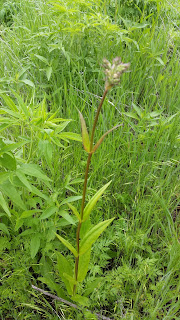 |
| Field Buffer, planted in 2008 Previous & current year's grasses shown, with shrub. |
However, there is a source of native grass seed all around the Creek Field in the field buffers, planted in 2008.
The field buffers were planted with a regular CRP native-plant mix, including grasses and native shrubs.
The photo above shows the field buffer, looking west.
 |
| Hedge Parsley, May 2015, (Torilis arvensis) Looking like a Monoculture. Non-native annual. Volunteer. |
At the beginning of May 2015 some parts of the Creek Field looked like a monoculture of Hedge Parsley, a weedy, non-native annual.
Monoculture was not what was going on, however, as perennials were breaking through the parsley blanket.
A lovely sedge was one of the first to appear.
 |
| Woodland Sedge, Carex blanda,. a native perennial, appears in the midst of the parsley. Male & female flowers depicted here. Carex blanda is a volunteer. |
 |
| Eastern Gama Grass (Tripsacum dactyloides), foreground. Bee Balm (Monarda fistulosa), mid-ground. Native perennials. In 2013 seed mix. |
The dead stalks in the photo are from last year's Hedge Parsley, as well as other annual weeds.
Note the new growth of Hedge Parsley around the base of these perennials.
 |
| Foxglove Penstemon (Penstemon digitalis) Native perennial. In 2013 seed mix. |
 |
| Foxglove Penstemon's gorgeous flowers! |
How excited I was to see for the first time dozens of Penstemons dotting the field!
One practitioner tells me there is a Foxglove Penstemon "phase" to prairie restorations.
If so, I hope it lasts a long time!
Not having to brush Hedge Parsley aside, because they went for bare spots along the edges of the buffers and the Creek Field, were the hardy Drummond's Asters. Thanks to Jeff Hansen for helping me to identify the new leaves!
 |
| New leaves of Drummon'd Aster (Symphyotrichum drummondii) Native Perennial Volunteer. |
 |
| The winged petiole (leaf stalk) helps to identify Drummond's Aster. Thank you, Jeff Hansen! |
No comments:
Post a Comment